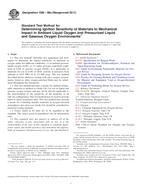Wir benötigen Ihre Einwilligung zur Verwendung der einzelnen Daten, damit Sie unter anderem Informationen zu Ihren Interessen einsehen können. Klicken Sie auf "OK", um Ihre Zustimmung zu erteilen.
ASTM G86-98a(2011)
Standard Test Method for Determining Ignition Sensitivity of Materials to Mechanical Impact in Ambient Liquid Oxygen and Pressurized Liquid and Gaseous Oxygen Environments (Includes all amendments And changes 2/14/2018).
Automatische name übersetzung:
Standard Test Methode zur Bestimmung der Zündung Sensitivity of Materials gegenüber mechanischer Einwirkung in Umgebungs flüssigem Sauerstoff und unter Druck flüssige und gasförmige Sauerstoff-Umgebungen
NORM herausgegeben am 1.4.2011
Informationen über die Norm:
Bezeichnung normen: ASTM G86-98a(2011)
Anmerkung: UNGÜLTIG
Ausgabedatum normen: 1.4.2011
SKU: NS-57852
Zahl der Seiten: 19
Gewicht ca.: 57 g (0.13 Pfund)
Land: Amerikanische technische Norm
Kategorie: Technische Normen ASTM
Kategorie - ähnliche Normen:
Ignitability and burning behaviour of materials and productsMilitary engineering. Military affairs. Weapons
Die Annotation des Normtextes ASTM G86-98a(2011) :
Keywords:
compatibility, ignition, impact test, mechanical impact, oxygen, pressurized oxygen, liquid oxygen, gaseous oxygen, Army ballistic missile impact tester, Compatibility, Ignition--rubber/cellular materials, Impact testing, Liquids--laboratory applications, Mechanical analysis/testing, Nonmetallic materials, Oxygen material compatibility, Oxygen-pressure method, Pressure testing--gaseous environments, Sensitivity criterion/response
Ergänzende Informationen
| Significance and Use | ||||||||||||||||||||||
|
This test method evaluates the relative sensitivity of materials to mechanical impact in ambient pressure liquid oxygen, pressurized liquid oxygen, and pressurized gaseous oxygen. Any change or variation in test sample configuration, thickness, preparation, or cleanliness may cause a significant change in impact sensitivity/reaction threshold. Suggested criteria for discontinuing the tests are: (1) occurrence of two reactions in a maximum of 60 samples or less tested at the maximum energy level of 98 J (72 ft•lbf) or one reaction in a maximum of 20 samples tested at any other energy level for a material that fails; (2) no reactions for 20 samples tested at the 98-J (72-ft•lbf) energy level; or (3) a maximum of one reaction in 60 samples tested at the maximum energy level. |
||||||||||||||||||||||
| 1. Scope | ||||||||||||||||||||||
|
1.1 This test method describes test equipment and techniques to determine the impact sensitivity of materials in oxygen under two different conditions: (1) in ambient pressure liquid oxygen (LOX) or (2) under pressure-controlled conditions in LOX or gaseous oxygen (GOX). It is applicable to materials for use in LOX or GOX systems at pressures from ambient to 68.9 MPa (0 to 10 000 psig). The test method described herein addresses testing with pure oxygen environments; however, other oxygen-enriched fluids may be substituted throughout this document. 1.2 This test method provides a means for ranking nonmetallic materials as defined in Guide G63 for use in liquid and gaseous oxygen systems and may not be directly applicable to the determination of the sensitivity of the materials in an end-use configuration. This test method may be used to provide batch-to batch acceptance data. This test method may provide a means for evaluating metallic materials in oxygen-enriched atmospheres also; however, Guide G94 should be consulted for preferred testing methods. 1.3 Values stated in SI units are to be regarded as the standard. The values given in parentheses are for information only. 1.4 This standard does not purport to address all of the safety concerns, if any, associated with its use. It is the responsibility of the user of this standard to establish appropriate safety and health practices and determine the applicability of regulatory limitations prior to use. See also Section 9. |
||||||||||||||||||||||
| 2. Referenced Documents | ||||||||||||||||||||||
|
Empfehlungen:
EEviZak – alle Gesetze einschließlich ihrer Evidenz in einer Stelle
Bereitstellung von aktuellen Informationen über legislative Vorschriften in der Sammlung der Gesetze bis zum Jahr 1945.
Aktualisierung 2x pro Monat!
Brauchen Sie mehr Informationen? Sehen Sie sich diese Seite an.




 Cookies
Cookies
